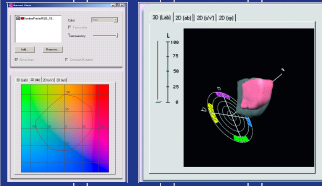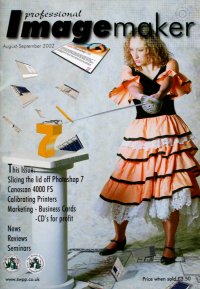articles/Printing/absolutepuzzle-page4
Absolute Puzzle - part 4 of 1 2 3 4
by Mike McNamee Published 01/08/2002

Gretag Macbeth ProfilerMaker 4.0 has sophisticated ways of comparing the gamuts of different profiles and printers. These may be viewed in Lab (3-D) or in 2-D as Lab, Luv or xyY.
With some trepidation we reproduce a dual scan of an image reproduced on the PG4000. The original was shot on the Kodak 760 and is presented with no changes other than the conversion to Euroscale Coated CMYK for reproduction. The spectrophotometer readings indicated that the unprofiled print lacked saturation in the model's face (was 16%, needed to be nearer 31%). The hue was actually quite close (was 28° needed to be 26°). After profiling, the magenta and yellow were boosted by 6% and 8% and the cyan was reduced by 3%. This removed some of the cyan cast, increased the saturation and "tanned" the model slightly - overall a more accurate and certainly more pleasing rendition. Both the PG4000 and PG3000 were changed in this way by the profiling. Even after profiling there was a slight loss in saturation compared to the data computed from the original image. This calculation was impeded by the use, in the Kodak 760 original of ProPhoto RGB a D50, Gamma 1.8 colour space. The result though was in line with our measurements off the Macbeth Chart, that is a slight loss of saturation which was greater for the unprofiled output.
Post Script
Parallel tests on inkjet output produced data of equal quality to that of the Pictrograph although inkjet paper prints never have quite the same "photographic feel" or look of the Fuji's output. We could not however replicate the data obtained by others, principally Bruce Fraser who has reported average Delta-E errors across the Macbeth Chart as low as 2.53 using the Logos software from the Gretag Macbeth profiling. Bruce Fraser's methodology is however slightly different in that he used an Absolute Colormetric rendering intent.
There is a generally recognised problem with 6-colour inkjet printers that they do not linearise well. By this we mean that a grey scale does not progress in even increments of tone. The ink changeover points from Light Magenta to Dark Magenta and from Light Cyan to Dark Cyan seems to upset the colour balance and cause a wavering of the colour bias in the scale. Although it is small in terms of the colourimetry, the eye is very sensitive to these colour shifts and they tend to stand out when the print is viewed critically. For this reason the Association of Photographers scheme for colour managed accreditation has yet to sanction any 6-colour SOHO inkjet printers. This may explain why critical observers choose Pictrograph prints ahead of inkjet prints - the Pictrograph is linearised and any bias in the grey tone scale tends to be more constant.

Correct viewing conditions are vital to accurate assessment of your prints. The image shows the set -up from which this magazine is designed. Note the warmth of the background overhead lighting compared to the cooler, controlled colour of the viewing booth which is set at 6500°K to match the calibrated monitor. The shot of the model compares the results before and after profiling the Fuji Pictrograph. The warmer tones on the right were a much more accurate rendering of the scene. Camera was the Kodak 760, Image courtesy of Leeds PhotoVisual, Manchester.
All of this is not to denounce the amazing performance of contemporary inkjet printers, there is a difference between a colourmetrically accurate print and a pleasing one. For the social photographer the making of portrait sales is of paramount importance; a slightly flattering tan might sell more copies of a portrait to a client regardless of an inferior Delta-E value. Other users may have different priorities.
Gretag Macbeth Eye1
The interfaces shown above are from the Eye1 profiling software and Profile Maker Professional 4.0. At the top the profiling target is displayed. A print from this target is made with all colour control on the printer turned off. These colours are then measured by aligning the plastic guide rail on the print and dragging the spectrophotometer along in a smooth sweep, taking about 5 seconds. The software is clever enough to tell you if you are on the wrong strip of colours or if you have moved too fast. The complete set of colours can be measured and converted to an icc profile in a couple of minutes. The shape of the profile may be displayed in 3-D and acts as a quick quality check. On the left, a profile made with a malfunctioning printer created a very odd 3-D plot that was obviously incorrect. You may also compare a number of profiles, as shown in the screen grabs to the right.
It is possible to "tweak" a profile for individual colours to emphasise the accuracy in specific areas of the colour gamut - handy if you need a small range of colour at great accuracy.
Overall the Eye1 has acquired a reputation for generating good profiles very speedily,mainly due to the use of its German (Logos) software. We certainly obtained our greatest accuracy with Eye1 and others have made similar claims. It is a piece of software we are keen to do some more analysis of and hopefully we will be able to report more in due course. The equipment is high end and carries a high end price tag of up to £2744, depending upon the options chosen.
Macbeth can be contacted on 0151 327 3920 or visit www.gretagmacbeth.com
CONCLUSIONS
We can only echo the words of McCamy et al from almost 25 years ago. However much has changed in the intervening period and the skills of colour have, to some extent, decamped from the press room and moved to the desk top. The scientists are striving to make life simpler but there is some way to go yet before the translation of colour in the studio to the printed page is trivially simple. Nevertheless it is very much easier than it used to be!
Please Note:
There is more than one page for this Article.
You are currently on page 4 Contact Mike McNamee
1st Published 01/08/2002
last update 09/12/2022 14:50:45
More Printing Articles
There are 0 days to get ready for The Society of Photographers Convention and Trade Show at The Novotel London West, Hammersmith ...
which starts on Wednesday 15th January 2025





